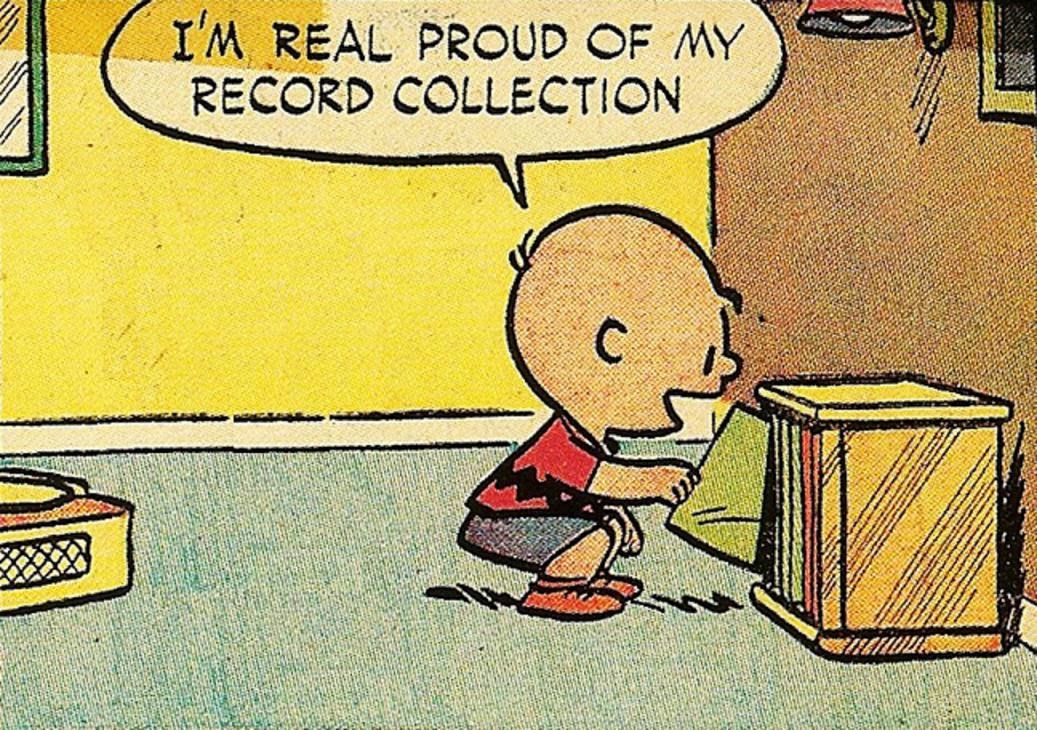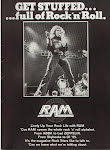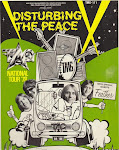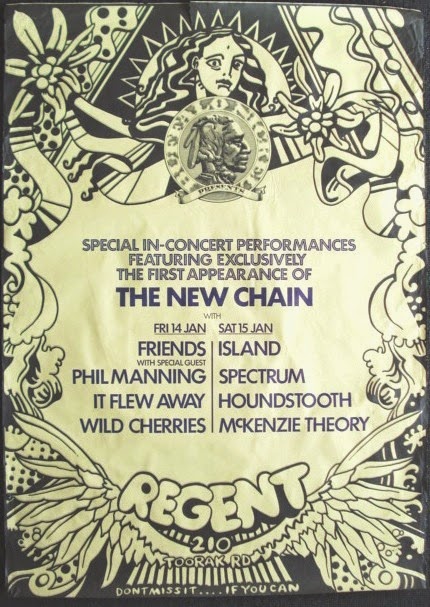.
 The Monkees (Michael Nesmith, Davy Jones, Micky Dolenz and Peter Tork) were pulled together in order to star in a successful comedy television show first aired on NBC in 1966.
The Monkees (Michael Nesmith, Davy Jones, Micky Dolenz and Peter Tork) were pulled together in order to star in a successful comedy television show first aired on NBC in 1966.The music for the series had been created by Don Kirschner and throughout the life of the band, many more esteemed songwriters added their input to The Monkees phenomenon, including Neil Diamond ("A Little Bit Me, A Little Bit You") and Carole King ("Pleasant Valley Sunday"). As time progressed the members of the band addressed the criticism which was leveled at them and began to exert more of a creative contribution; initially they had only provided vocals, by the third album Headquarters they were writing and playing much of their own stuff.
Pressure mounted for the fictional Monkees to tour, and by the British tour in 1967, they were sufficiently proficient to do so.
The band began to fracture in 1968 when Tork quit, exacerbated by Nesmith leaving the group in 1970. Shortly after that Dolenz and Jones lost the rights to call themselves The Monkees although they continued to tour. The whole band toured and reformed off and on throughout the ongoing years to varying
 degrees of success as their previous fame ebbed and flowed. Their 11th album Justus (1996) was, at last, their chance to create a 100% Monkees product.
degrees of success as their previous fame ebbed and flowed. Their 11th album Justus (1996) was, at last, their chance to create a 100% Monkees product.Dismissing them as 'manufactured', seems harsh. Many other bands and singers have performed other people's music, lacing it with their own efforts. The Monkees did so with a certain amount of charisma, energy and humor; as a result they are, most certainly, entertainers in their own right. They released six albums with the full line-up, four of which hit No.1 on the Billboard chart, and several of their singles have found their place in public affections including "I'm a Believer", "(I'm Not Your) Steppin' Stone", "Daydream Believer" and "Last Train to Clarksville" [extract from Sound Unwound].
.
 The 1967 Tour
The 1967 TourThe Monkees' 1967 summer tour commenced in Hollywood, California with a performance at the Hollywood Bowl. The instrumental lineup was similar to the first regional tour done a couple months earlier, with Micky on drums and tympani, Mike on lead guitar, Peter on bass guitar, keyboards and banjo, and Davy playing tambourine and the maracas. Davy would also occasionally play bass guitar when Peter moved to the keyboards and he would relieve Micky on drums during "Randy Scouse Git" and towards the end of “Mary, Mary.” Images of The Monkees performing and other selected footage were projected on large screens behind the band.
The 1967 concerts were critically acclaimed, and the crowds large and hysterical. The performances included a psychedelic light show, one of the first concert tours to feature such techniques. The last three North American dates (Seattle, Washington 25/8/67, Portland, Oregon 26/8/67 and Spokane, Washington 27/8/67)  were recorded with the intent of releasing a live album. That album did not see the light of day until it was finally released as Live 1967 in 1987. The 12/8/67 performance at the Municipal Auditorium in Mobile, Alabama is a widely circulated bootleg recording. Summer 1967: The Complete U.S. Concert Recordings features four complete concerts from this tour, and was previously available as a limited edition release from Rhino Handmade.
were recorded with the intent of releasing a live album. That album did not see the light of day until it was finally released as Live 1967 in 1987. The 12/8/67 performance at the Municipal Auditorium in Mobile, Alabama is a widely circulated bootleg recording. Summer 1967: The Complete U.S. Concert Recordings features four complete concerts from this tour, and was previously available as a limited edition release from Rhino Handmade.
The Jimi Hendrix Experience was the opening act for several American cities on the summer tour. Hendrix joined the Monkees' tour in progress on July 8, 1967 in Jacksonville, Florida, continuing through Miami on July 9, Charlotte, North Carolina on July 11 and Greensboro, North Carolina on July 12. He departed after three shows in Forest Hills, New York on July 14, 15 and 16, 1967 (see ticket stub above). Hendrix, a star in England but relatively unknown in his native United States, was trying to gain notoriety in America. As the New York Times noted in 2006, “The Monkees wanted respect, and Hendrix wanted publicity."
 were recorded with the intent of releasing a live album. That album did not see the light of day until it was finally released as Live 1967 in 1987. The 12/8/67 performance at the Municipal Auditorium in Mobile, Alabama is a widely circulated bootleg recording. Summer 1967: The Complete U.S. Concert Recordings features four complete concerts from this tour, and was previously available as a limited edition release from Rhino Handmade.
were recorded with the intent of releasing a live album. That album did not see the light of day until it was finally released as Live 1967 in 1987. The 12/8/67 performance at the Municipal Auditorium in Mobile, Alabama is a widely circulated bootleg recording. Summer 1967: The Complete U.S. Concert Recordings features four complete concerts from this tour, and was previously available as a limited edition release from Rhino Handmade.The Jimi Hendrix Experience was the opening act for several American cities on the summer tour. Hendrix joined the Monkees' tour in progress on July 8, 1967 in Jacksonville, Florida, continuing through Miami on July 9, Charlotte, North Carolina on July 11 and Greensboro, North Carolina on July 12. He departed after three shows in Forest Hills, New York on July 14, 15 and 16, 1967 (see ticket stub above). Hendrix, a star in England but relatively unknown in his native United States, was trying to gain notoriety in America. As the New York Times noted in 2006, “The Monkees wanted respect, and Hendrix wanted publicity."
 ."The Jimi Hendrix Experience were the apotheosis of ’60s psychedelic ribbon shirts and tie-dye—they had pinwheels for eyes and their hair was out to here. I thought, “Man, I gotta see this thing live.” So that night I stood in front of the stage and listened to Hendrix at soundcheck. And I thought, “Well, this guy’s from Mars; he’s from some other planet, but whatever it is, thank heaven for this visitation.” And I listened to him play at the soundchecks and the concert. I thought, “This is some of the best music I’ve heard in my life.” [Michael Nesmith, speaking about Jimi Hendrix]
."The Jimi Hendrix Experience were the apotheosis of ’60s psychedelic ribbon shirts and tie-dye—they had pinwheels for eyes and their hair was out to here. I thought, “Man, I gotta see this thing live.” So that night I stood in front of the stage and listened to Hendrix at soundcheck. And I thought, “Well, this guy’s from Mars; he’s from some other planet, but whatever it is, thank heaven for this visitation.” And I listened to him play at the soundchecks and the concert. I thought, “This is some of the best music I’ve heard in my life.” [Michael Nesmith, speaking about Jimi Hendrix].
Mike, when attending a dinner party in England with Paul McCartney, John Lennon and Eric Clapton, overheard a tape of Hendrix playing. Along with Micky and Peter, they became instant fans, and after watching Hendrix perform at the Monterey Pop Festival in June 1967, the Monkees pushed for Hendrix to open their U.S. summer concerts. With the Monkees on the road to dispel the critical notion that they couldn't play live, adding an act as cutting edge and theatrical as the Jimi Hendrix Experience would further prove the seriousness of the Monkees as musicians and entertainers.
The musical pairing was an odd one, and various Monkees have recounted in the years since that their audience was less than interested in the guitar virtuoso, often chanting 'Monkees!' or 'We want Davy!' while Hendrix performed. As the arrangement didn't work with the crowds coming to the concerts, Hendrix and company eventually left the tour amicably.
.
 .It was reported that both the Monkees and the Experience got along and even jammed. The exposure of being on tour with the hottest act in America propelled Hendrix to the next level as his music began to be noticed in the United States. There is no truth to the urban legend (originally reported by Australian rock critic Lillian Roxon, who traveled with the tour, as a tongue-in-cheek explanation for Hendrix's sudden departure) that Hendrix was dismissed after a complaint by the Daughters of the American Revolution of "lewd and indecent" conduct during his performances.
.It was reported that both the Monkees and the Experience got along and even jammed. The exposure of being on tour with the hottest act in America propelled Hendrix to the next level as his music began to be noticed in the United States. There is no truth to the urban legend (originally reported by Australian rock critic Lillian Roxon, who traveled with the tour, as a tongue-in-cheek explanation for Hendrix's sudden departure) that Hendrix was dismissed after a complaint by the Daughters of the American Revolution of "lewd and indecent" conduct during his performances. Other opening acts included The Sundowners, who provided instrumental backup during the solo segments, and Lynn Randell. British star Lulu opened the concerts at Wembley in London, England, and Epifocal Phringe supplied backup during the solo performances.
Other opening acts included The Sundowners, who provided instrumental backup during the solo segments, and Lynn Randell. British star Lulu opened the concerts at Wembley in London, England, and Epifocal Phringe supplied backup during the solo performances.The 1967 concerts were a critical and commercial coup for the Monkees. This, combined with the previous success of gaining complete artistic control over the making of their music, solidified the Monkees as a musical force in 1967. After the tour, the band channeled these accomplishments in the studio (recording the "Pleasant Valley Sunday" single and Pisces, Aquarius, Capricorn and Jones LTD) while also resuming filming of their Emmy award-winning television show, now ready to enter into its second season.
.
Review
Apparently, the Monkees used to not only fake their existence on TV and in the studio; they had to take a more active part in it by going out on tour and making nice fresh bucks for their employers. This was rendered all the more encumbering by the fact that, as we all know, the Monkees were just a wee bit inexperienced about playing their own instruments. To be more
 exact, urged on by Mike Nesmith, Talented Monkee #1, they'd finally started getting acquainted with man's musical instrument legacy in the studio, but that's one thing; quite another one is to be able to harness these instruments in a live setting, where you're not allowed to do double takes unless you're a comedy act or something.
exact, urged on by Mike Nesmith, Talented Monkee #1, they'd finally started getting acquainted with man's musical instrument legacy in the studio, but that's one thing; quite another one is to be able to harness these instruments in a live setting, where you're not allowed to do double takes unless you're a comedy act or something.Hey, wait a minute. This is a comedy act we're talking about. And the only saving grace for the Monkees, once they were pushed onto the stage and the curtains behind them locked and barred tight until they'd played the entire setlist, was to push on with the comedy - and pray comedy would be comic enough for the audience so as to avoid the rotten tomatoes. I haven't counted exactly, but I have a naggin' feeling that the stage banter during this one hour occupies at least as much time as the actual playing, if not more. (And, for the record, this is the entire length of the show I'm talking here: the new CD release of Rhino's 1987 album adds four "solo" tracks to the former LP, which constitutes the entire setlist for the band's mid-'67 live show).
The actual tour has, of course, long since gone down in history as the infamous "Hendrix opening for the Monkees" event, arguably the most absurd pairing in the history of rock music, with poor Jimi as the main victim of the situation: people were
 coming to see the well-established Monkees, not the barely-known Hendrix, and, naturally, it was a bit unusual to accept stuff like 'Purple Haze' as a substitute, or even as an aperitif before 'Forget That Girl' and 'I'm A Believer'. Nevertheless, as far as I know, there was little conflict between Jimi and the Monkees themselves; in fact, they even used to jam together a little bit, which, for Nesmith and Co., must have looked like a God-sent gift. Curiously enough, the hard-rocking version of '(I'm Not Your) Steppin' Stone' which closes the concert definitely has some Hendrix overtones to it, with its use of feedback, noise, and almost free-form soloing at times; I do, however, suspect that most of the actual music on that particular track is played by one of their several other supporting bands that, for a few numbers, took the playing
coming to see the well-established Monkees, not the barely-known Hendrix, and, naturally, it was a bit unusual to accept stuff like 'Purple Haze' as a substitute, or even as an aperitif before 'Forget That Girl' and 'I'm A Believer'. Nevertheless, as far as I know, there was little conflict between Jimi and the Monkees themselves; in fact, they even used to jam together a little bit, which, for Nesmith and Co., must have looked like a God-sent gift. Curiously enough, the hard-rocking version of '(I'm Not Your) Steppin' Stone' which closes the concert definitely has some Hendrix overtones to it, with its use of feedback, noise, and almost free-form soloing at times; I do, however, suspect that most of the actual music on that particular track is played by one of their several other supporting bands that, for a few numbers, took the playing  over from the Monkees to give them more room for singing. And save them at least some embarrassment.
over from the Monkees to give them more room for singing. And save them at least some embarrassment.Highlights include a rabble-rousing Dolenz performance on 'Randy Scouse Git' and, unbelievable as it seems, 'I Wanna Be Free', which, with added volume, bombastic rhythm section, and Jones' inability to play it subtle and suave in a live setting (he almost literally has to shout out the lyrics), suddenly becomes a good-time folk anthem, perfectly singalongable, particularly if you're busy hiding from bad weather somewhere in your log cabin in North Dakota. Of course, the songs that were previously interesting from a musical point of view are butchered fair and square ('Last Train To Clarksville', 'I'm A Believer'), and the formerly sparkling vocal harmonies are completely out of tune, but here we go complaining again.
By far the most interesting part for fans and collectors will be the four bonus tracks, an integral part of the show that was left out in the LP age - the band's "solo" spots. Tork's country-western sendup has already been mentioned; Nesmith also has one with the equally fun and simplistic, but far more long-winded (and long-titled) 'You Can't Judge A Book By Looking At The Cover'; Jones gets himself the cute bouncy ballad 'Gonna Build A Mountain'; and Dolenz kicks the most ass with the lightning-speed rave-up of 'I Got A Woman', finally showing why he really was the best singer in the band and a good candidate for intoxicating frontman as well.
In other words, Live 1967 hangs somewhere in between historical document and independent entertainment - it's a bit
 too "unimportant" to be recommended as the former, and way too messy to be recommended as the latter, but if you're hunting for unique experiences, don't pass it by. It sounds like nothing else in the world. [Review by George Starostin at Only Solitare]
too "unimportant" to be recommended as the former, and way too messy to be recommended as the latter, but if you're hunting for unique experiences, don't pass it by. It sounds like nothing else in the world. [Review by George Starostin at Only Solitare].
This post consists of a rip taken from CD (1987 - now deleted) and includes artwork for both CD and Vinyl. The CD release includes 4 bonus tracks (solo tracks by each of the four Monkees) which were not available on the vinyl release (due to length restraints).
Although this is not their best recording, the live renditions are quite good considering their age and the audience consisting primarily of 8 to 14 year old girls!
Note: The Monkees went on tour the following year in 1968, visiting Australia and Japan. For information regarding their tour 'Down Under', see the Monkees' official website.
Track Listing

01 - Last Train to Clarksville
02 - You May Be the One
03 - The Girl I Knew Somewhere
04 - I Wanna Be Free
05 - Sunny Girlfriend
06 - Your Auntie Grizelda
07 - Forget That Girl
08 - Sweet Young Thing
09 - Mary, Mary
10 - * Cripple Creek (Peter Tork solo spot)
11 - * You Can't Judge A Book By Looking At The Cover
(Michael Nesmith solo spot)
12 - * Gonna Build A Mountain (Davy Jones solo spot)
13 - * I Got A Woman (Micky Dolenz solo spot)
14 - I'm a Believer
15 - Randy Scouse Git
16 - (I'm Not Your) Steppin' Stone
* Bonus tracks only on CD
.
The Monkees:
Peter Tork - bass, vocals, keyboards
Davy Jones - vocals, guitars
Micky Dolenz - drums, vocals
Michael Nesmith - guitars, vocals
RIP - This post is dedicated to Davy Jones who sadly passed away recently on Febuary 29th, 2012 at the age of 66. News sources indicate that he died of a heart attack.
.
The Monkees Live Link (115Mb) New Link 03/01/2024
.
12 - * Gonna Build A Mountain (Davy Jones solo spot)
13 - * I Got A Woman (Micky Dolenz solo spot)
14 - I'm a Believer
15 - Randy Scouse Git
16 - (I'm Not Your) Steppin' Stone
* Bonus tracks only on CD
.

The Monkees:
Peter Tork - bass, vocals, keyboards
Davy Jones - vocals, guitars
Micky Dolenz - drums, vocals
Michael Nesmith - guitars, vocals
RIP - This post is dedicated to Davy Jones who sadly passed away recently on Febuary 29th, 2012 at the age of 66. News sources indicate that he died of a heart attack.
.
The Monkees Live Link (115Mb) New Link 03/01/2024
.















Hi mate,
ReplyDeleteGlen in Sydney here. I don't say thanks enough very much. So thanks for the blog and all the great stuff lately, incl this one. I saw the Monkees with my sister at the old Stadium in Sydney. They were so amazing.
Glen
Hey Glen
ReplyDeleteThanks for taking the time to drop in and say thanks - its nice to know that all of the hard work is not always taken for granted.
I grew up watching these guys as a kid but wasn't living in the city at the time, so never got the opportunity to see them when they came out in 1968. Or was it the 1986 / 1988 reunion concerts you're referring to?
Anyhow - 'I'm Still A Believer' after all of these years :-) Cheers mate
Aussie,
ReplyDeleteWondering if you could update the link ( once again ) for this Monkees title. Tried the Turbobit link but did not connects.
thanks for making this recording available.
cheers
WoodyNET
Link not working, ulozto.net have a page for it but the free download doesn't work.
ReplyDelete